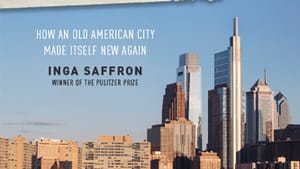Stay in the Loop
BSR publishes on a weekly schedule, with an email newsletter every Wednesday and Thursday morning. There’s no paywall, and subscribing is always free.
New city, new readers
‘Becoming Philadelphia’ by Inga Saffron

Inga Saffron has been the architecture critic for the Inquirer since 1999, chronicling a period when Philadelphia has seen stunning changes in its physical fabric. Unlike other Rust Belt cities, such as Detroit, we’ve had major development successes over the last 20 years; we’ve also had recurring failures (Penns Landing; the old Gimbels location at 8th and Market).
Saffron documented and commented on these changes. She has never limited herself to critiquing finished buildings; she covers the political and economic jockeying behind development decisions. Agree with her or not, her column is a must-read for people interested in design, urban planning, and local politics.
Eighty of those columns have now been gathered into Becoming Philadelphia: How an Old American City Made Itself New Again, which also includes a new 16-page introduction by Saffron. Unfortunately, while the individual essays retain their tang and insight, the book as a whole is disappointing.
Changing readers
Successful writers—however you want to define success—write with their readers in mind. While a newspaper columnist’s audience is less geographically limited than it once was, even today it’s primarily local. Often addressing events of local interest, the columnist can assume a shared baseline understanding of the players and issues involved.
That baseline understanding, however, dissolves with the passage of time. Understanding the political activities in City Hall requires that you know who’s acting. We all know the current cast of characters, but who was mayor in 2006, to pick a random year? Who was city council president? Who else was on city council that year?
Because those kinds of details are no longer top of mind, a person reading this collection of Saffron’s columns isn’t a member of the same audience that read the pieces when they were first published. And even if the same people read the original columns and the book, the passage of time means they’re not the same readers: they’re reading in a different context and with a different purpose.
So the editor’s decisions on presenting the collected columns—basically as originally published, and now grouped thematically but without additional information or a way to navigate through the book—don’t serve the reader well.
What’s missing?
The biggest problem is the lack of follow-up. In a newspaper, the reader knows that the question “What happened next?” will be answered in the coming weeks or months. When that same column is republished in book form, the issue has been resolved, but the reader of Becoming Philadelphia needs to jump on Google to figure out what the resolution was. The book would benefit from a paragraph explaining the denouement.
Equally annoying is the lack of an index. Even if you know a particular topic has been addressed in the book, it’s impossible to find an individual column other than by paging through the entire volume. Though the columns have been divided into eight sections, the names of the individual sections are more evocative than informative.
For instance, I wanted to cite Saffron’s column on Burholme Park as a piece that would have benefitted from a follow-up. I eventually found that November 2008 column—describing Fox Chase Cancer Center’s attempt to purchase 20 acres of the 65-acre park in Northeast Philadelphia for its own expansion—in the section titled “Sweating the Small Stuff” (where else?).
Saffron reported on the effort in the context of political actions by mayors Street and Nutter and the then-recent vote to merge the Fairmount Park Commission with the Parks and Recreation Department. Left completely up in the air was any indication of whether the land grab had been successful. (I went online to discover that no, it was not; it was blocked by a court decision the following month. Three years later, the center’s expansion needs were apparently met by its 2011 affiliation with Temple, which gave it Jeanes Hospital.) But why should I have to put down the book to find that out?
The second draft of history
If journalism is the first draft of history, a collection of newspaper columns can be considered the second draft. Especially for an academic press, it behooves the editor to provide updates and organization.
I guess a scholar who was researching any of the dozens of issues that Saffron touches on here, and who wanted a contemporary take on them, could conduct a Google search, rather than thumbing through the book’s index while standing in a bookstore. (Full disclosure: I left academia 30+ years ago, so my mental model of the research process is sadly outdated.) But wouldn’t the publisher benefit from selling that scholar a copy of the book?
And then there’s the casual reader (like me, for instance, speaking of the same person being a different reader as the years go by). I’m a Saffron fan who enjoys her perspective and ability to turn a phrase and wanted to revisit what she saw as her best columns. But the ill-explained thematic groupings proved challenging when I wanted to follow a thread. Certain topics (proposed projects at Penns Landing, the Paseo Verde apartments adjacent to Temple’s regional rail station, Philly’s tax abatement) recur, but if you’re reading along and think “Hm, didn’t she talk about this already?” you have no way of confirming that, let alone finding the other references.
So, is this is a “thumbs down” review? Not entirely. If you’re a fan, sure, go ahead. You’ll encounter columns you remember and others you don’t, and if you’re just reading along uncritically, you’ll probably enjoy them all.
Just be prepared for frustration if you want anything more.
What, When, Where
Becoming Philadelphia: How an Old American City Made Itself New Again. By Inga Saffron. Piscataway: Rutgers University Press, June 12, 2020. 272 pages, paperback; $29.95. Get it here.
Sign up for our newsletter
All of the week's new articles, all in one place. Sign up for the free weekly BSR newsletters, and don't miss a conversation.

 Judy Weightman
Judy Weightman